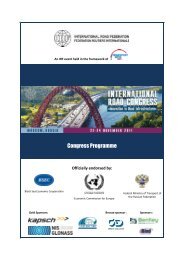Motorways and Urban Mobility - International Road Federation
Motorways and Urban Mobility - International Road Federation
Motorways and Urban Mobility - International Road Federation
Create successful ePaper yourself
Turn your PDF publications into a flip-book with our unique Google optimized e-Paper software.
INTELLIGENT TRANSPORT SYSTEMS<br />
INTELLIGENT TRANSPORT SYSTEMS<br />
Video Incident Detection for<br />
Advanced Traffic Management<br />
Systems under Indian Traffic<br />
Conditions<br />
Dr Kayitha Ravinder, Dr S. Velmurugan &<br />
Dr S. Gangopadhyay<br />
Central <strong>Road</strong> Research Institute,<br />
New Delhi, India<br />
Introduction<br />
The New Delhi based Central <strong>Road</strong> Research Institute (CRRI)<br />
has successfully demonstrated two ITS pilot projects forming<br />
part of an Advanced Traffic Management System, namely<br />
a Video Incident Detection System (VIDS) <strong>and</strong> an Advanced<br />
Parking Management System (APMS). This study focuses<br />
on the efficacy of VIDS for advanced traffic management<br />
under Indian conditions in locations where lane discipline is<br />
seldom adhered to. The principal objective of the study is to<br />
apply video image processing for incident detection (using<br />
Citilog software) on a typical urban section of the country’s<br />
NH-2 Highway to assess effectiveness of incident detection<br />
<strong>and</strong> accuracy in evaluating traffic flow parameters. The<br />
study further elaborates on the various VIDS parameters as<br />
well as the reliability <strong>and</strong> adaptability of the system.<br />
VIDS parameters<br />
The Video Incident Detection System (VIDS) parameters can<br />
be adjusted, <strong>and</strong> it is always possible to revert to the default<br />
settings. This flexibility is important as the settings directly<br />
affect the processing <strong>and</strong> image analysis programme<br />
for the lane in question. Any incorrect adjustments can<br />
generate problems such as false alarms, or cause incidents<br />
to go undetected. The following is the list of parameters<br />
for VIDS l:<br />
- Traffic slow-down alarm<br />
- Slow vehicle alarm<br />
- Wrong way alarm<br />
- Stop in fluid traffic alarm<br />
- Stop in congested traffic alarm<br />
- Speeding alarm<br />
The abovementioned operations are shown in Figures 1<br />
<strong>and</strong> 2.<br />
Figure 1: Lane configuration of the Video<br />
Incident Detection System<br />
Figure 2: Operation of four cameras, comprising<br />
two PTZ <strong>and</strong> two fixed<br />
Installation strategy <strong>and</strong> field study<br />
A typical urban, six lane, divided carriageway on NH-2 was<br />
selected for the study. Two locations, a mid block <strong>and</strong> a<br />
signalised T intersection, were selected for the installation<br />
of cameras. At each location, two video cameras – one fixed<br />
<strong>and</strong> one Pan-Tilt <strong>and</strong> Zoom (PTZ) – were set up. The fixed<br />
cameras covered six lanes of the carriageway while the PTZ<br />
cameras covered three. Incident detection <strong>and</strong> traffic flow<br />
data from all four cameras was collected over an entire day,<br />
from 9 am to 5 pm.<br />
IRF BULLETIN SPECIAL EDITION: URBAN MOBILITY | | 14

















